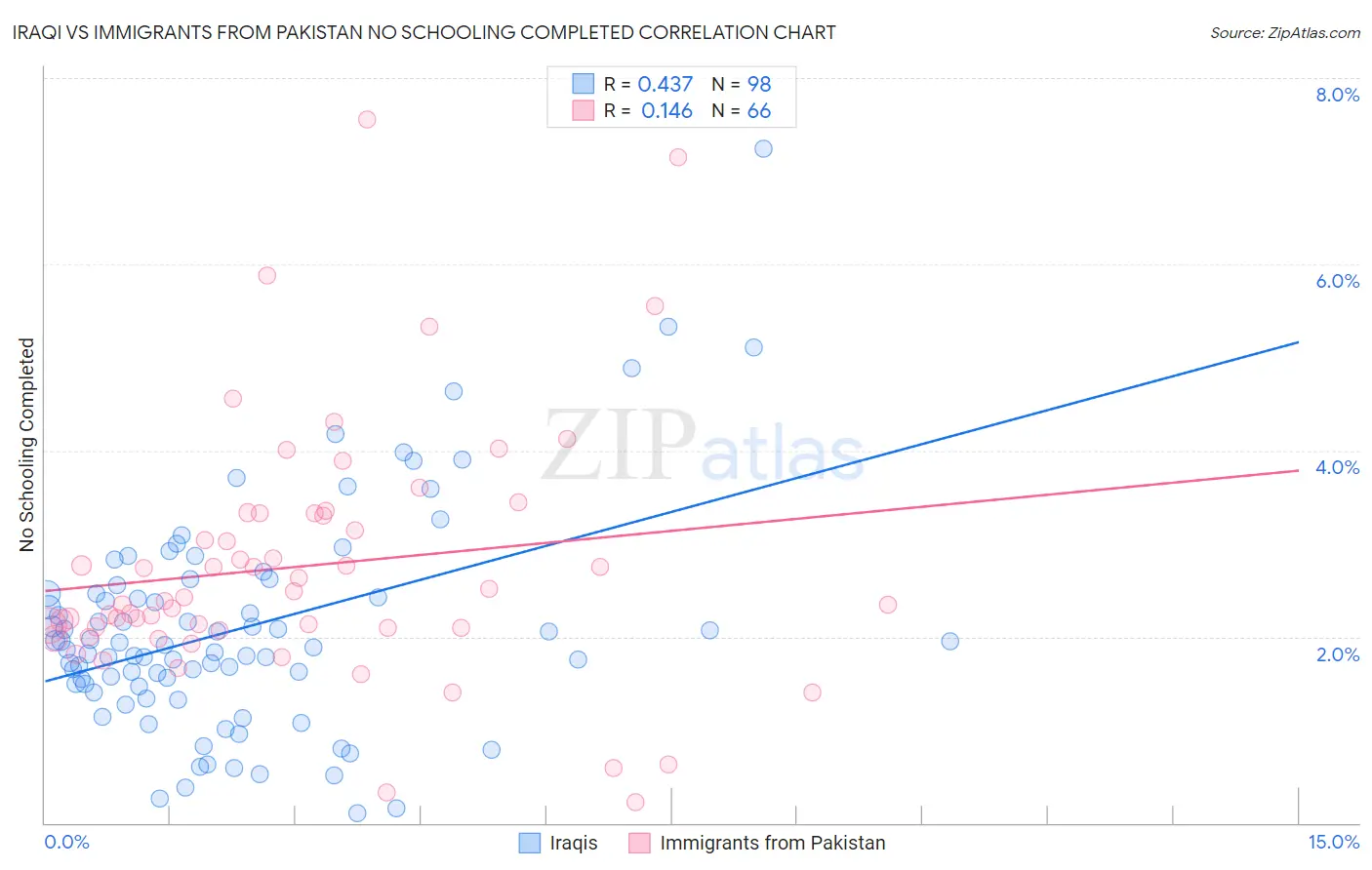Iraqi vs Immigrants from Pakistan No Schooling Completed
COMPARE
Iraqi
Immigrants from Pakistan
No Schooling Completed
No Schooling Completed Comparison
Iraqis
Immigrants from Pakistan
2.4%
NO SCHOOLING COMPLETED
2.2/ 100
METRIC RATING
236th/ 347
METRIC RANK
2.3%
NO SCHOOLING COMPLETED
3.6/ 100
METRIC RATING
229th/ 347
METRIC RANK
Iraqi vs Immigrants from Pakistan No Schooling Completed Correlation Chart
The statistical analysis conducted on geographies consisting of 170,150,046 people shows a moderate positive correlation between the proportion of Iraqis and percentage of population with no schooling in the United States with a correlation coefficient (R) of 0.437 and weighted average of 2.4%. Similarly, the statistical analysis conducted on geographies consisting of 282,572,391 people shows a poor positive correlation between the proportion of Immigrants from Pakistan and percentage of population with no schooling in the United States with a correlation coefficient (R) of 0.146 and weighted average of 2.3%, a difference of 1.5%.

No Schooling Completed Correlation Summary
| Measurement | Iraqi | Immigrants from Pakistan |
| Minimum | 0.10% | 0.23% |
| Maximum | 7.2% | 7.5% |
| Range | 7.1% | 7.3% |
| Mean | 2.1% | 2.8% |
| Median | 1.9% | 2.4% |
| Interquartile 25% (IQ1) | 1.5% | 2.1% |
| Interquartile 75% (IQ3) | 2.5% | 3.3% |
| Interquartile Range (IQR) | 0.97% | 1.2% |
| Standard Deviation (Sample) | 1.2% | 1.4% |
| Standard Deviation (Population) | 1.2% | 1.4% |
Demographics Similar to Iraqis and Immigrants from Pakistan by No Schooling Completed
In terms of no schooling completed, the demographic groups most similar to Iraqis are Immigrants from Eastern Asia (2.4%, a difference of 0.20%), Paiute (2.4%, a difference of 0.41%), Liberian (2.4%, a difference of 0.53%), Immigrants from Western Asia (2.3%, a difference of 0.54%), and Nigerian (2.3%, a difference of 0.56%). Similarly, the demographic groups most similar to Immigrants from Pakistan are U.S. Virgin Islander (2.3%, a difference of 0.080%), Puerto Rican (2.3%, a difference of 0.13%), Immigrants from Uruguay (2.3%, a difference of 0.16%), Immigrants from Uganda (2.3%, a difference of 0.37%), and Colombian (2.3%, a difference of 0.38%).
| Demographics | Rating | Rank | No Schooling Completed |
| Sub-Saharan Africans | 4.7 /100 | #222 | Tragic 2.3% |
| Immigrants | Lebanon | 4.5 /100 | #223 | Tragic 2.3% |
| Tohono O'odham | 4.1 /100 | #224 | Tragic 2.3% |
| Sudanese | 4.1 /100 | #225 | Tragic 2.3% |
| Sierra Leoneans | 4.1 /100 | #226 | Tragic 2.3% |
| Immigrants | Uganda | 4.0 /100 | #227 | Tragic 2.3% |
| U.S. Virgin Islanders | 3.7 /100 | #228 | Tragic 2.3% |
| Immigrants | Pakistan | 3.6 /100 | #229 | Tragic 2.3% |
| Puerto Ricans | 3.4 /100 | #230 | Tragic 2.3% |
| Immigrants | Uruguay | 3.4 /100 | #231 | Tragic 2.3% |
| Colombians | 3.2 /100 | #232 | Tragic 2.3% |
| Immigrants | Malaysia | 2.8 /100 | #233 | Tragic 2.3% |
| Nigerians | 2.6 /100 | #234 | Tragic 2.3% |
| Immigrants | Western Asia | 2.6 /100 | #235 | Tragic 2.3% |
| Iraqis | 2.2 /100 | #236 | Tragic 2.4% |
| Immigrants | Eastern Asia | 2.0 /100 | #237 | Tragic 2.4% |
| Paiute | 1.9 /100 | #238 | Tragic 2.4% |
| Liberians | 1.8 /100 | #239 | Tragic 2.4% |
| Immigrants | Senegal | 1.7 /100 | #240 | Tragic 2.4% |
| Koreans | 1.7 /100 | #241 | Tragic 2.4% |
| Immigrants | Indonesia | 1.5 /100 | #242 | Tragic 2.4% |